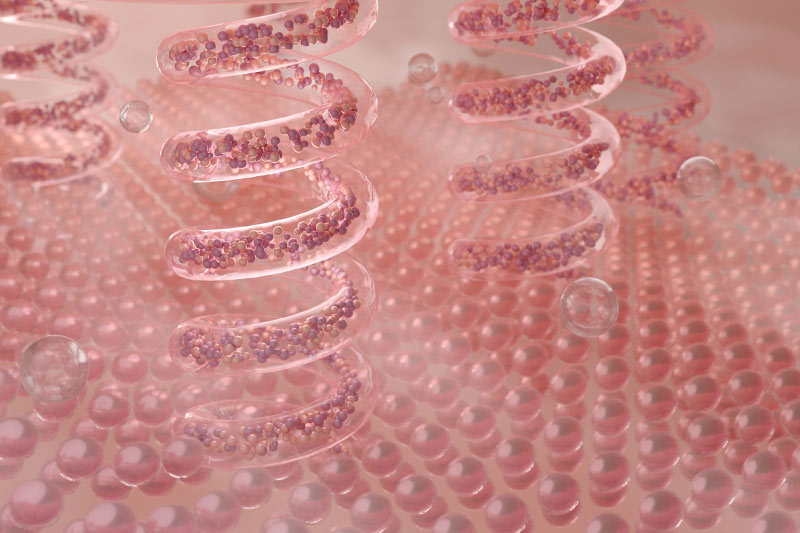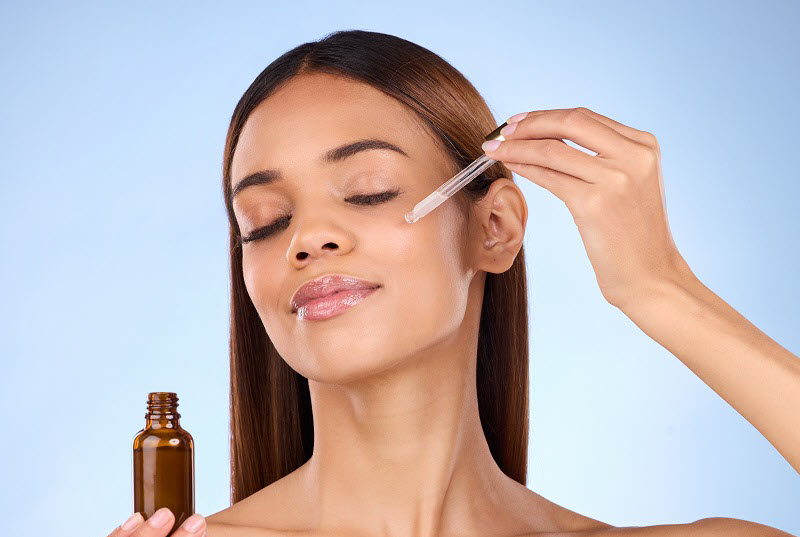The loss of collagen and elastin is why skin aging signs start to appear. But what factors cause the degradation of these two essential skin-building proteins? What exactly is their role in our bodies, and can we enhance their production?
This article looks at the similarities and differences between collagen and elastin, explains how to recognize their deficiency, and gives recommendations on how to increase their production.

Collagen vs. Elastin: What Are the Differences?
The following table gives an overview of the differences between collagen and elastin.
| Collagen | Elastin | |
|---|---|---|
| What is it? | The most abundant protein in our bodies and skin – 90% of all dermal layers. | An important skin-building protein – up to 10% of all dermal layers. |
| Where is it found? | Connective tissue, blood vessels, skin, intestinal lining. | Major blood vessels, lungs, elastic ligaments, tendons, skin. |
| Main functions: | Gives strength, support, and structure to skin. | Provides resilience and elasticity to skin. |
| Longevity | Production declines in mid-20s. | Production declines or stops after puberty. |
| Causes of deficiency | Aging, sun exposure, sugar, nicotine, autoimmune disorders. | Aging, sun exposure, nicotine, sudden weight loss/gain, stress, medical issues. |
| Treatments | Healthy nutrition, topical skin care, exercise, cosmetic treatments. | Healthy nutrition, topical skin care, exercise, cosmetic treatments. |
| Fun fact | Type 1 collagen fibers are 5-10 times stronger than steel. | Elastin is 1,000 times more flexible than collagen. |
Let’s take a closer look at how collagen and elastin differ.
Collagen vs. Elastin: Overview
Collagen and elastin are naturally occurring proteins in our bodies, primarily synthesized by fibroblasts – the most common cell types in connective tissue. They are the most abundant proteins in the dermis – the middle skin layer – and give it support and structure.
What Is Collagen?
Collagen is primarily made from the amino acids proline, glycine, and hydroxyproline. It accounts for 30% of all body protein and most of the protein in the dermis. Scientists have identified 28 types of collagens, the most abundant being type 1.
Collagen production typically peaks in our early 20s and then decreases by 1% each year.
Note: Learn more about the benefits of collagen for the skin.
What Is Elastin?
Elastin primarily consists of the amino acids proline, glycine, desmosine, and isodesmosine. It accounts for about 30% of dry mass in blood vessels, 50% in elastic ligaments, and 2-3% in the skin. Most of its production occurs during neonatal development and declines or ends when a person reaches maturity.
Collagen vs. Elastin: Function
Collagen and elastin play a crucial role in maintaining the skin’s health and youthful appearance. They have different functions but complement one another, especially after injury when they work together to regenerate the skin.
Collagen Function
Collagen’s main functions are to provide scaffolding and strength to tissues. It also gives a protective covering for organs, assists in blood clotting, helps cell turnover, and strengthens the skin. During peak collagen, the skin production is firm, supple, and wrinkle-free.
Elastin Function
Elastin’s role is to enable tissues to stretch and rebound after stretching. Thanks to elastin, lungs expand and contract during breathing, and arteries are flexible to accommodate pumping blood.
Because of elastin, the skin of young people recoils to its former state immediately after being pinched and becomes smooth after frowning.
Note: Learn how to rejuvenate the skin following our expert tips and product recommendations.
Collagen vs. Elastin: Where Can They Be Found?

Collagen and elastin are the main constituents of connective tissue. Collagen and elastin fibers are interwoven in the dermis to provide a dense and stable support structure, but these proteins also appear elsewhere in the body.
Where Can Collagen Be Found?
Collagen is found in the following tissues and organs:
- Skin
- Bones
- Tendons
- Ligaments
- Muscles
- Arteries
- Intestinal lining
- Eye cornea
Where Can Elastin Be Found?
Elastin is found in all tissues that need to stretch, such as:
- Large blood vessels (e.g., aorta)
- Lungs
- Bladder
- Some ligaments
- Ear cartilage
- Skin
Collagen vs. Elastin: Signs of Deficiency
Collagen and elastin deficiencies are the main causes of aging signs, but they can also affect our physical performance and other health issues.
Collagen Deficiency
The following symptoms typically appear due to collagen deficiency.
- Fine lines and wrinkles
- Sunken eyes
- Joint and muscle pain
- Brittle bones, hair, and nails
- Thinning hair
- Slow recovery from injury
- Gastrointestinal problems
Elastin Deficiency
The following symptoms characterize elastin deficiency.
- Loose, sagging skin
- Slow recovery from injury
- Shortness of breath
- Fatigue
- Vascular problems (narrowing of arteries, blood clotting, etc.)
- Worsening of scars and stretch marks
Note: Learn how microneedling stretch marks can help reduce them and enhance the skin.
Collagen vs. Elastin: Causes of Deficiency

Aging, environmental factors, and lifestyle habits are the main causes of collagen and elastin deficiency.
Causes of Collagen Deficiency
These are the primary factors causing collagen breakdown.
- Aging
- Sun exposure
- High sugar intake
- Nicotine
- Autoimmune collagen disorders
Causes of Elastin Deficiency
These factors degrade elastin.
- Aging
- Sun exposure
- Nicotine
- Sudden weight loss/gain
- Some medical conditions (e.g., emphysema, atherosclerosis)
- Stress
Collagen vs. Elastin: How to Increase Them?
Collagen and elastin naturally decline with age, but there are solutions to stimulate more collagen and maintain native elastin.
How to Increase Collagen?
Our bodies continue to produce collagen throughout life, albeit at a declining rate. We can enhance its synthesis in the following ways.
- Adequate nutrition
Foods rich in nutrients that assist fibroblasts in making collagen may help enhance collagen production. These nutrients are vitamin C, zinc, and copper, and the foods that contain them include leafy greens, citrus fruits, tomatoes, shellfish, nuts, beans, and whole grains.
Foods with amino acids may also increase collagen, and they include meat, eggs, and dairy. Bone broth is rich in collagen and may also be a good way to build more of this protein in your body.
- Collagen supplements
Clinical research and user experience show promising results for collagen supplements. Many patients experience a significant increase in skin firmness and elasticity, and the supplements improve their overall appearance.
Vibrant Skin Bar recommends Elevate (previously known as Collagen Activator), a highly effective supplement that provides various health benefits, from healthier-looking skin and stronger muscles to an enhanced immune system and libido.
- Dermal fillers
Dermal fillers are cosmetic injectables that stimulate collagen production. Brands like Radiesse and Sculptra contain calcium hydroxylapatite and poly-L-lactic acid, respectively, which provide a scaffold for new tissue growth in areas affected by collagen loss. After the fillers dissolve, newly formed collagen takes their place to provide volume and rejuvenate the treatment area.
- Topical skin care
According to the American Academy of Dermatology Association, serums and creams with retinoids (vitamin A derivatives) can enhance the skin’s metabolism and stimulate collagen production. Our skin experts at Vibrant Skin Bar recommend Osmosis MD Renew Advanced Retinal Serum for its potent collagen-boosting formulation with nine collagen stimulators, including Niacinamide, Retinal, and Palmitoyl Tripeptide-38.
Aside from retinoids, skin experts maintain that daily sunscreen use is the most important step in topical skin care for every skin issue, including collagen loss.
Note: Prepare for the summer and read our blog post on what is sunscreen and why you should never leave the house without it.
- Exercise
Studies show exercise has great potential in enhancing skin health, from aiding in toxin removal and clearing the skin, to stimulating collagen production through increased blood flow. The best exercises for enhancing collagen production include running, cycling, weightlifting, and other activities that increase circulation.
How to Increase Elastin?
The production of elastin stops early in life. Currently, no treatments can introduce new functional elastin into the skin. Most treatments are aimed at preserving existing elastin reserves.
- Sunscreen
Sunscreen is a must for all skin-related issues, including signs of skin aging due to elastin loss. Sunscreens block the effects of UV rays that accelerate elastin breakdown, maintaining a firmer, youthful complexion.
- Retinoids

Retinol stimulates the activity of fibroblasts, potentially increasing the production of elastin fibers. It also removes degenerated elastin fibers, improving skin elasticity and firmness. Use retinoid products at night because they increase sensitivity to the sun.
- Balanced nutrition
Foods that help preserve elastin include leafy greens, fatty fish, citrus fruits, and nuts. Avoid foods high in carbohydrates because they trigger inflammation, causing damage to elastin fibers.
- Quit smoking
Nicotine accelerates the breakdown of skin-building components, such as collagen, elastin, and hyaluronic acid. Reducing or eliminating nicotine can help maintain healthy elastin fibers and firmer skin.
- Exercise
Exercise can indirectly help preserve elastin levels by improving blood circulation, the supply of nutrients to cells, and skin cell metabolism. Incorporate a mix of cardio, strength training, and HIIT exercises for a minimum of 150 minutes per week for optimal results.
- Dermal fillers
Radiesse is a filler that contains calcium hydroxylapatite. Radiesse promotes both collagen and elastin production in new tissue.
Conclusion
Collagen and elastin are the building blocks of our skin, bones, muscles, and other organs and tissues. They affect our health and appearance, so it’s in our best interest to maintain optimal levels for as long as we can. We can do that by incorporating healthier lifestyle habits, quality skincare products, dietary supplements, and innovative cosmetic treatments that help enhance collagen and elastin levels.


